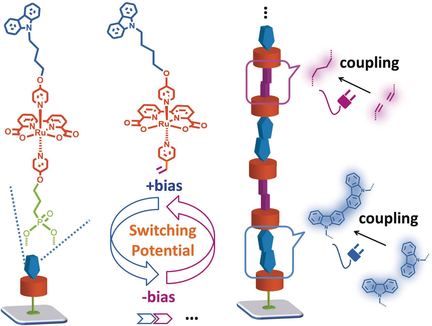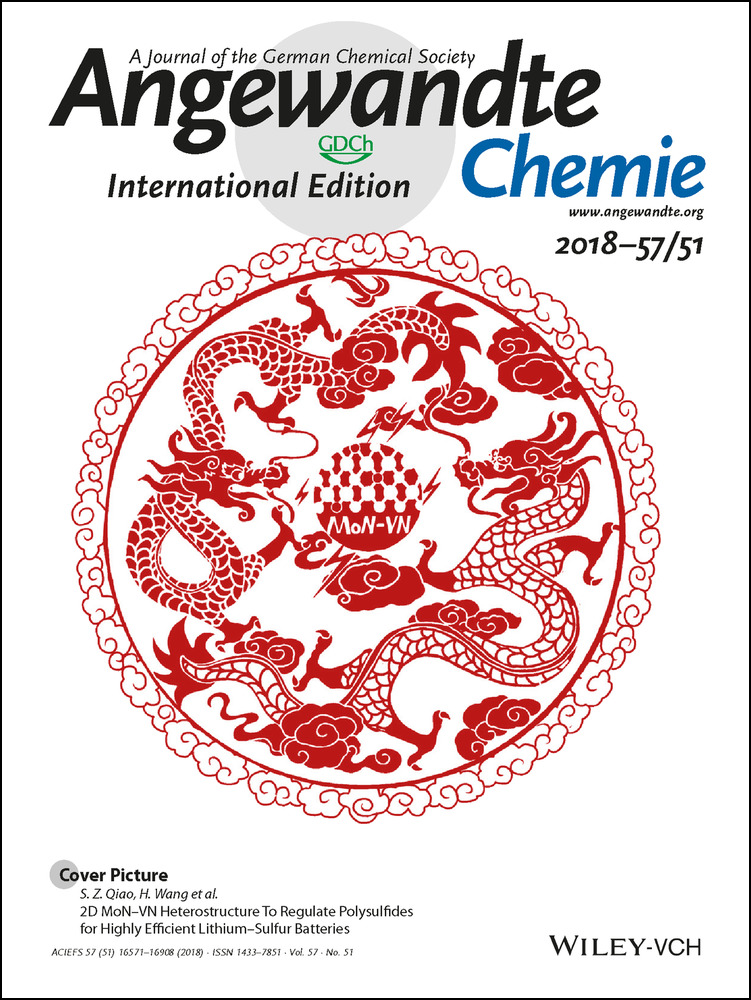Vertical Step-Growth Polymerization Driven by Electrochemical Stimuli from an Electrode
Jian Zhang
State Key Laboratory of Polymer Physics and Chemistry, Changchun Institute of Applied Chemistry (CIAC), Changchun, 130022 China
University of the Chinese Academy of Sciences, Beijing, 100049 China
Search for more papers by this authorJia Du
State Key Laboratory of Polymer Physics and Chemistry, Changchun Institute of Applied Chemistry (CIAC), Changchun, 130022 China
Search for more papers by this authorJinxin Wang
State Key Laboratory of Polymer Physics and Chemistry, Changchun Institute of Applied Chemistry (CIAC), Changchun, 130022 China
University of Science and Technology of China, Hefei, 230026 China
Search for more papers by this authorYanfang Wang
State Key Laboratory of Polymer Physics and Chemistry, Changchun Institute of Applied Chemistry (CIAC), Changchun, 130022 China
Search for more papers by this authorChang Wei
State Key Laboratory of Polymer Physics and Chemistry, Changchun Institute of Applied Chemistry (CIAC), Changchun, 130022 China
University of Science and Technology of China, Hefei, 230026 China
Search for more papers by this authorCorresponding Author
Prof. Dr. Mao Li
State Key Laboratory of Polymer Physics and Chemistry, Changchun Institute of Applied Chemistry (CIAC), Changchun, 130022 China
University of the Chinese Academy of Sciences, Beijing, 100049 China
Search for more papers by this authorJian Zhang
State Key Laboratory of Polymer Physics and Chemistry, Changchun Institute of Applied Chemistry (CIAC), Changchun, 130022 China
University of the Chinese Academy of Sciences, Beijing, 100049 China
Search for more papers by this authorJia Du
State Key Laboratory of Polymer Physics and Chemistry, Changchun Institute of Applied Chemistry (CIAC), Changchun, 130022 China
Search for more papers by this authorJinxin Wang
State Key Laboratory of Polymer Physics and Chemistry, Changchun Institute of Applied Chemistry (CIAC), Changchun, 130022 China
University of Science and Technology of China, Hefei, 230026 China
Search for more papers by this authorYanfang Wang
State Key Laboratory of Polymer Physics and Chemistry, Changchun Institute of Applied Chemistry (CIAC), Changchun, 130022 China
Search for more papers by this authorChang Wei
State Key Laboratory of Polymer Physics and Chemistry, Changchun Institute of Applied Chemistry (CIAC), Changchun, 130022 China
University of Science and Technology of China, Hefei, 230026 China
Search for more papers by this authorCorresponding Author
Prof. Dr. Mao Li
State Key Laboratory of Polymer Physics and Chemistry, Changchun Institute of Applied Chemistry (CIAC), Changchun, 130022 China
University of the Chinese Academy of Sciences, Beijing, 100049 China
Search for more papers by this authorGraphical Abstract
A step up: Vertical step-growth polymerization of a monomer A-B through individual A–A and B–B coupling reactions driven by electrochemically positive and negative bias on a self-assembled A or B electrode enabled the sequence- and topology-controlled synthesis of molecular wires with single-molecule precision (see picture). The resulting surface-confined molecular wires showed fast electron transfer and excellent electrocatalytic performance.
Abstract
We present herein the vertical step-growth polymerization of a monomer A-B through individual A–A or B–B coupling driven by electrochemical switching of positive and negative bias on a self-assembled A or B electrode. The monomer RuII(bda)AB (bda=2,2′-bipyridine-6,6′-dicarboxylate), in which A and B are pyridine moieties with pendant carbazolyl and vinyl groups, could be dimerized at oxidative (ca. 1.0 V vs. Ag/Ag+) or reductive potential (ca. −1.8 V) to give a self-assembled RuII(bda)PA or RuII(bda)PB monolayer (P=pyridine with a pendant phosphonic acid) on ITO glass. This polymerization enabled the sequence- and topology-controlled synthesis of surface-confined molecular wires with single-molecule precision on an electrode. The electrocatalytic performance of the vertically orientated molecular wires for water oxidation increased with increasing molecular length and exceeded that of both the self-assembled monolayer and a randomly electropolymerized film, which have previously been studied as typical models.
Supporting Information
As a service to our authors and readers, this journal provides supporting information supplied by the authors. Such materials are peer reviewed and may be re-organized for online delivery, but are not copy-edited or typeset. Technical support issues arising from supporting information (other than missing files) should be addressed to the authors.
| Filename | Description |
|---|---|
| anie201809567-sup-0001-misc_information.pdf2 MB | Supplementary |
Please note: The publisher is not responsible for the content or functionality of any supporting information supplied by the authors. Any queries (other than missing content) should be directed to the corresponding author for the article.
References
- 1
- 1aZ. Liu, A. A. Yasseri, J. S. Lindsey, D. F. Bocian, Science 2003, 302, 1543;
- 1bT. Gupta, M. E. van der Boom, Angew. Chem. Int. Ed. 2008, 47, 5322; Angew. Chem. 2008, 120, 5402;
- 1cA. Vilan, D. Cahen, Chem. Rev. 2017, 117, 4624;
- 1dA. Vilan, D. Aswal, D. Cahen, Chem. Rev. 2017, 117, 4248.
- 2
- 2aV. Singh, P. C. Mondal, A. K. Singh, M. Zharnikov, Coord. Chem. Rev. 2017, 330, 144;
- 2bE. R. Dionne, A. Badia, ACS Appl. Mater. Interfaces 2017, 9, 5607.
- 3
- 3aM. K. Brennaman, R. J. Dillon, L. Alibabaei, M. K. Gish, C. J. Dares, D. L. Ashford, R. L. House, G. J. Meyer, J. M. Papanikolas, T. J. Meyer, J. Am. Chem. Soc. 2016, 138, 13085;
- 3bJ. C. Wang, S. P. Hill, T. Dilbeck, O. O. Ogunsolu, T. Banerjee, K. Hanson, Chem. Soc. Rev. 2018, 47, 104.
- 4
- 4aP. Pallavicini, G. Dacarroa, Y. A. Diaz-Fernandezb, A. Taglietti, Coord. Chem. Rev. 2014, 275, 37;
- 4bA. Prévoteau, K. Rabaey, ACS Sens. 2017, 2, 1072.
- 5J. E. Greene, Appl. Phys. Rev. 2015, 2, 011101.
- 6
- 6aJ. F. Stoddart, Acc. Chem. Res. 2001, 34, 410;
- 6bN. Pavliček, L. Gross, Nat. Rev. Chem. 2017, https://doi.org/10.1038/s41570-016-0005;
- 6cR. Otero, J. M. Gallego, A. L. Vázquez de Parga, N. Martín, R. Miranda, Adv. Mater. 2011, 23, 5148.
- 7
- 7aR. B. Merrifield, Science 1965, 150, 178;
- 7bR. B. Merrifield, Angew. Chem. Int. Ed. Engl. 1985, 24, 799; Angew. Chem. 1985, 97, 801.
- 8
- 8aG. de Ruiter, M. Lahav, M. E. van der Boom, Acc. Chem. Res. 2014, 47, 3407;
- 8bP. C. Mondal, V. Singh, M. Zharnikov, Acc. Chem. Res. 2017, 50, 2128;
- 8cR. Sakamoto, K.-H. Wu, R. Matsuoka, H. Maeda, H. Nishihara, Chem. Soc. Rev. 2015, 44, 7698;
- 8dE. Katz, G. Scheller, T. M. Putvinski, M. L. Schilling, W. L. Wilson, C. E. D. Chidsey, Science 1991, 254, 1485;
- 8eH. Byrd, E. P. Suponeva, A. B. Bocarsly, M. E. Thompson, Nature 1996, 380, 610.
- 9
- 9aG. M. Credo, A. K. Boal, K. Das, T. H. Galow, V. M. Rotello, D. L. Feldheim, C. B. Gorman, J. Am. Chem. Soc. 2002, 124, 9036;
- 9bK. Terada, H. Nakamura, K. Kanaizuka, M. Haga, Y. Asai, T. Ishida, ACS Nano 2012, 6, 1988;
- 9cG. Zeng, J. Gao, S. Chen, H. Chen, Z. Wang, X. Zhang, Langmuir 2007, 23, 11631;
- 9dM. D. Yilmaz, J. Huskens, Soft Matter 2012, 8, 11768.
- 10
- 10aA. B. Descalzo, R. Martínez-Máñez, F. Sancenón, K. Hoffmann, K. Rurack, Angew. Chem. Int. Ed. 2006, 45, 5924; Angew. Chem. 2006, 118, 6068;
- 10bF. Tancini, D. Genovese, M. Montalti, L. Cristofolini, L. Nasi, L. Prodi, E. Dalcanale, J. Am. Chem. Soc. 2010, 132, 4781;
- 10cT. Ogoshi, S. Takashima, T. Yamagishi, J. Am. Chem. Soc. 2015, 137, 10962.
- 11
- 11aC. Friebe, M. D. Hager, A. Winter, U. S. Schubert, Adv. Mater. 2012, 24, 332;
- 11bB. J. Holliday, T. M. Swager, Chem. Commun. 2005, 23;
- 11cJ. Heinze, B. A. Frontana-Uribe, S. Ludwigs, Chem. Rev. 2010, 110, 4724.
- 12P. M. Beaujuge, J. R. Reynolds, Chem. Rev. 2010, 110, 268.
- 13N. Haddour, J. Chauvin, C. C. Gondran, S. Cosnier, J. Am. Chem. Soc. 2006, 128, 9693.
- 14
- 14aD. L. Ashford, A. M. Lapides, A. K. Vannucci, K. Hanson, D. A. Torelli, D. P. Harrison, J. L. Templeton, T. J. Meyer, J. Am. Chem. Soc. 2014, 136, 6578;
- 14bF. Li, K. Fan, L. Wang, Q. Daniel, L. Duan, L. Sun, ACS Catal. 2015, 5, 3786;
- 14cL. Wang, K. Fan, Q. Daniel, L. Duan, F. Li, B. Philippe, H. Rensmo, H. Chen, J. Sun, L. Sun, Chem. Commun. 2015, 51, 7883;
- 14dD. L. Ashford, B. D. Sherman, R. A. Binstead, J. L. Templeton, T. J. Meyer, Angew. Chem. Int. Ed. 2015, 54, 4778; Angew. Chem. 2015, 127, 4860.
- 15
- 15aL. Duan, L. Wang, F. Li, L. Sun, Acc. Chem. Res. 2015, 48, 2084;
- 15bV. Kunz, D. Schmidt, M. I. S. Röhr, R. Mitrić, F. Würthner, Adv. Energy Mater. 2017, 7, 1602939;
- 15cT. J. Meyer, M. V. Sheridan, B. D. Sherman, Chem. Soc. Rev. 2017, 46, 6148;
- 15dL. Duan, F. Bozoglian, S. Mandal, B. Stewart, T. Privalov, A. Llobet, L. Sun, Nat. Chem. 2012, 4, 418;
- 15eD. Wang, S. L. Marquard, L. Troian-Gautier, M. V. Sheridan, B. D. Sherman, Y. Wang, M. S. Eberhart, B. H. Farnum, C. J. Dares, T. J. Meyer, J. Am. Chem. Soc. 2018, 140, 719.
- 16Z. Fang, S. Keinan, L. Alibabaei, H. Luo, A. Ito, T. J. Meyer, Angew. Chem. Int. Ed. 2014, 53, 4872; Angew. Chem. 2014, 126, 4972.
- 17M. Li, S. Ishihara, M. Akada, M. Liao, L. Sang, J. P. Hill, V. Krishnan, Y. Ma, K. Ariga, J. Am. Chem. Soc. 2011, 133, 7348.
- 18
- 18aM. Li, S. Kang, J. Du, J. Zhang, J. Wang, K. Ariga, Angew. Chem. Int. Ed. 2018, 57, 4936; Angew. Chem. 2018, 130, 5030;
- 18bM. Li, Chem. Eur. J. 2018, https://doi.org/10.1002/chem.201803246.
- 19
- 19aC. Xia, R. C. Advincula, Chem. Mater. 2001, 13, 1682;
- 19bY. Lv, L. Yao, C. Gu, Y. Xu, D. Liu, D. Lu, Y. Ma, Adv. Funct. Mater. 2011, 21, 2896;
- 19cM. Oçafrain, T. K. Tran, P. Blanchard, S. Lenfant, S. Godey, D. Vuillaume, J. Roncali, Adv. Funct. Mater. 2008, 18, 2163.
- 20
- 20aB. Zhang, F. Li, R. Zhang, C. Ma, L. Chen, L. Sun, Chem. Commun. 2016, 52, 8619;
- 20bY. Tsubonouchi, S. Lin, A. R. Parent, G. W. Brudvig, K. Sakai, Chem. Commun. 2016, 52, 8018;
- 20cM. Schulze, V. Kunz, P. D. Frischmann, F. Würthner, Nat. Chem. 2016, 8, 576.
- 21
- 21aC. C. L. McCrory, S. Jung, J. C. Peters, T. F. Jaramillo, J. Am. Chem. Soc. 2013, 135, 16977;
- 21bY. Yoon, B. Yan, Y. Surendranath, J. Am. Chem. Soc. 2018, 140, 2397.
- 22
- 22aD. Bu, Y. Xiong, Y. N. Tan, M. Meng, P. J. Low, D.-B. Kuang, C. Y. Liu, Chem. Sci. 2018, 9, 3438;
- 22bY. Zheng, A. J. Giordano, R. C. Shallcross, S. R. Fleming, S. Barlow, N. R. Armstrong, S. R. Marder, S. S. Saavedra, J. Phys. Chem. C 2016, 120, 20040;
- 22cR. Sakamoto, S. Katagiri, H. Maeda, H. Nishihara, Coord. Chem. Rev. 2013, 257, 1493;
- 22dR. Sakamoto, S. Katagiri, H. Maeda, Y. Nishimori, S. Miyashita, H. Nishihara, J. Am. Chem. Soc. 2015, 137, 734.
- 23
- 23aD. Lebedev, Y. Pineda-Galvan, Y. Tokimaru, A. Fedorov, N. Kaeffer, C. Copéret, Y. Pushkar, J. Am. Chem. Soc. 2018, 140, 451;
- 23bD. W. Shaffer, Y. Xie, D. J. Szalda, J. J. Concepcion, J. Am. Chem. Soc. 2017, 139, 15347.





